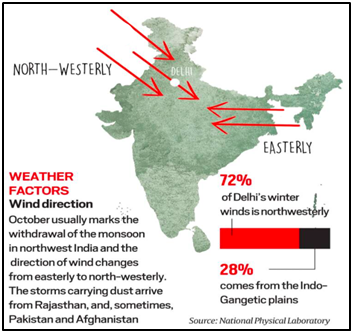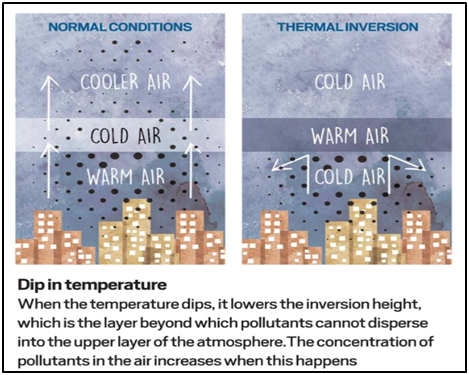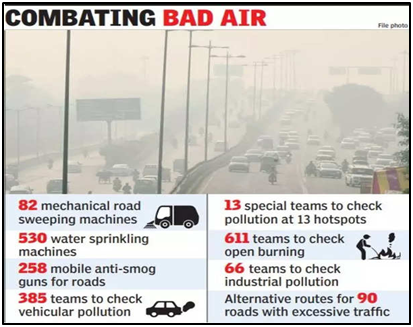Why in News?
- Chief Minister Arvind Kejriwal announced a 15-point action plan to deal with air pollution during winter, when the city struggles with smog, poor visibility, and a drop in air quality mainly due to meteorological factors and stubble burning.
What’s in Today’s Article?
- Factors that cause air pollution
- Measures needed to be taken
- News Summary
Factors that cause Air Pollution in Delhi & the Indo Gangetic Plains:
- Air pollution in Delhi and the whole of the Indo Gangetic Plains is a complex phenomenon that is dependent on a variety of factors.
- Especially in the months of October and November every year, the region’s air quality starts to dip significantly.
Wind Direction:

- Winds from the Bay of Bengal blow northwards, carrying smoke from the rest of the country towards the Himalayas, before hitting a block there.
- This wind deposits particulate matter, including smoke and dust, along the northern belt of states adjoining the mountain range, with no room for dispersal away from the region.
Temperature Inversion:

- Along with the change in wind direction, the dip in temperatures is also behind the increased pollution levels.
- As temperature dips, the inversion height — which is the layer beyond which pollutants cannot disperse into the upper layer of the atmosphere – is lowered.
- An inversion traps air pollution such as smog close to the ground. An inversion can also suppress convection by acting as a "cap".
- The concentration of pollutants in the air increases when this happens.
Dry and Still Air during Winters:
- Normally, rain and wind work to reduce air pollution. The wind disperses the pollutants while rains wash away the particulate matters which then settle on the ground.
- But, during the winter months, both rain and strong winds are unavailable. In absence of that, the pollutants remain suspended in the air similar to a white sheet.
Stubble Burning:
- Farm fires in Punjab and Haryana — resulting from the burning of crop residue to prepare farms for Rabi sowing and tackle pests — is one of the major factors stoking the dense smog that envelops north India every winter.
- A 2015 study on Delhi’s air pollution conducted by IIT-Kanpur states that 17-26% of all particulate matter in Delhi in winters is because of biomass burning.
- Over the years, the System of Air Quality and Weather Forecasting and Research (SAFAR) has developed a system to calculate the contribution of stubble burning to Delhi’s pollution.
- SAFAR is a national initiative by the Ministry of Earth Sciences (MoES) to measure the air quality of a metropolitan city, by measuring the overall pollution level and the location-specific air quality of the city.
- In 2020, as per SAFAR, during peak stubble burning incidents, its contribution to air pollution rose to 40%.
Measures to Reduce Air Pollution in the Region:
- While factors such as location, wind speed, temperature inversion, etc. are natural phenomenon.
- However, man-made causes for air pollution in Delhi and the NCR region such as stubble burning, construction, etc. can be eliminated with necessary measures:
Preventing Stubble Burning:
- Over the years, the governments of Punjab and Haryana have taken different steps to curb this practice.
- This includes incentives for industries to use the residue (by both states), and monetary benefits for farmers (financial constraints have proved an impediment in Punjab), besides awareness campaigns.
- Furthermore, the Central Government has subsidised machinery meant to tackle the stubble.
- Plants that utilize paddy straw as fuel for creating energy are coming up in Punjab.
- At the same time, collection and export of this straw would enable business opportunities for the farmers and interested parties.
Preventing Construction-related Pollution:
- Construction is one of the leading sources of pollution in the region, with very little policies in place to maintain certain environmental standards.
- In countries like Hong Kong, a netted mesh across the construction area can often be seen, this would reduce the amount of material, which is blown into the air.
- While some of the developers in the National Capital Region, do follow these practices, more often than not, in an effort to save their margins these practices will be ignored unless mandated by the government to follow.
Cloud Seeding:
- Cloud seeding is the practice of creating artificial precipitation to take place by dispersing substances like salts into the air through aircraft.
- Precipitation would force the pollutants in the air to be brought onto the ground and hence improve the air quality.
- This technology is already being used by China, US, Israel, South Africa and Germany for years.
News Summary:
- Chief Minister Arvind Kejriwal announced a 15-point action plan to deal with air pollution during winter.
- The plan includes several focus areas, including controlling stubble burning, vehicular pollution, open burning, and dust pollution.
- It also calls for the formation of special teams to enforce some of the existing bans, such as the one on open garbage burning.
- The government will use bio-decomposer over 5,000 acres of farmland this year.
- The bio-decomposer is a microbial liquid spray which, when sprayed onto paddy stubble, breaks it down in a way that can be easily absorbed into the soil, whereby farmers then have no need to burn the stubble.
- The government has identified 13 pollution hotspots and that specific action plans have been prepared for each.

Improvement in Recent Times:
- PM2.5 and PM10 levels in Delhi had reduced by nearly 30% between 2014 and 2022, marking a significant improvement in the air quality.
- PM2.5 and PM10 (particulate matter 2.5 and 10) are fine inhalable particles that can get into the lungs and bloodstream and lead to various respiratory and other diseases.
- Also, in 2022, stubble burning had fallen by 30% compared to the previous year.










